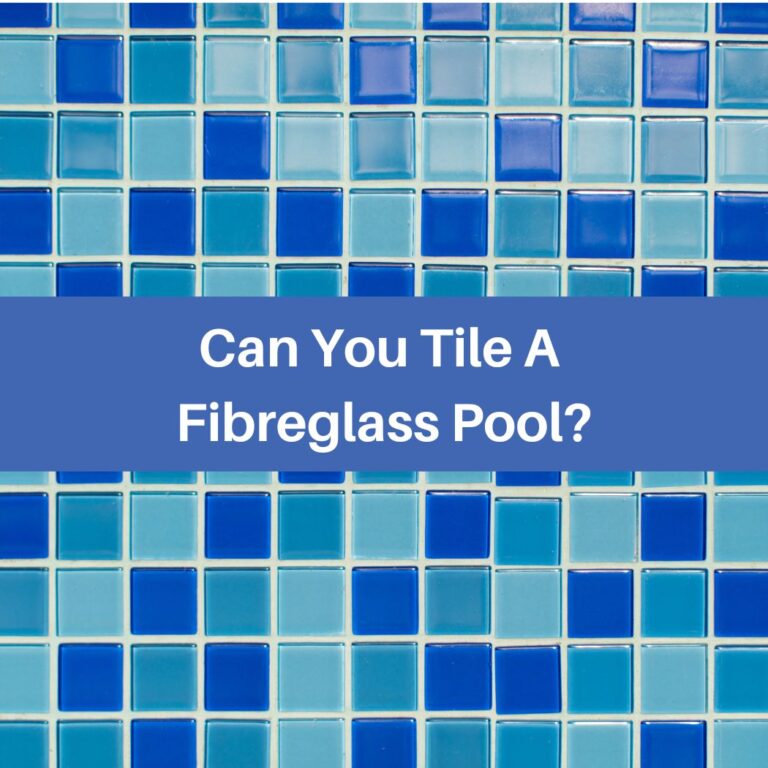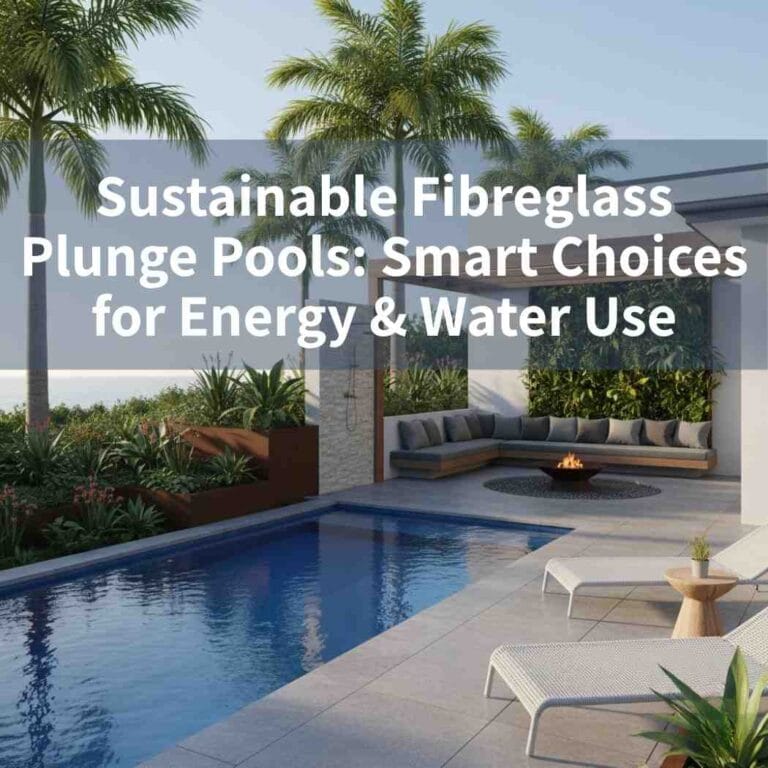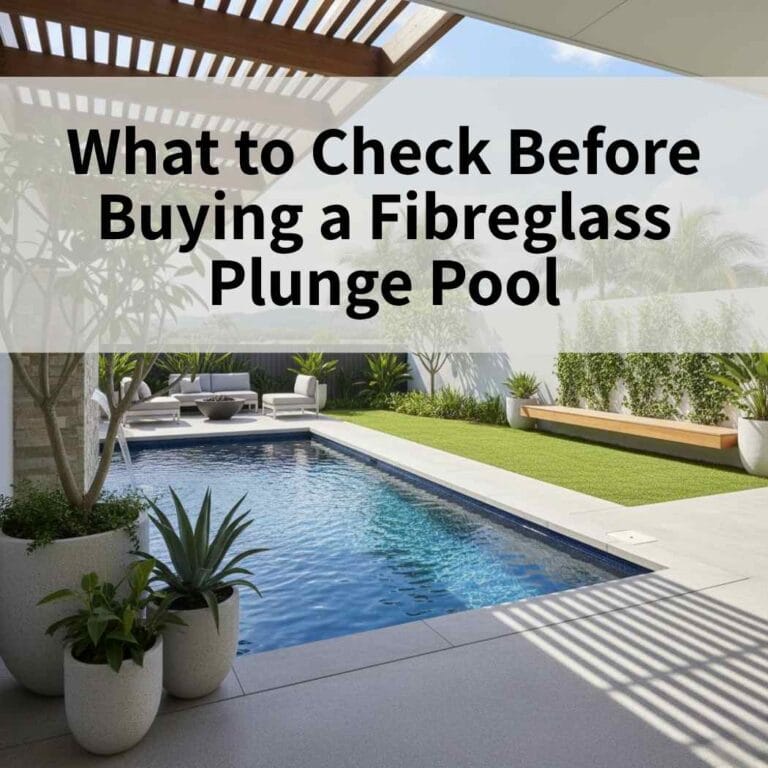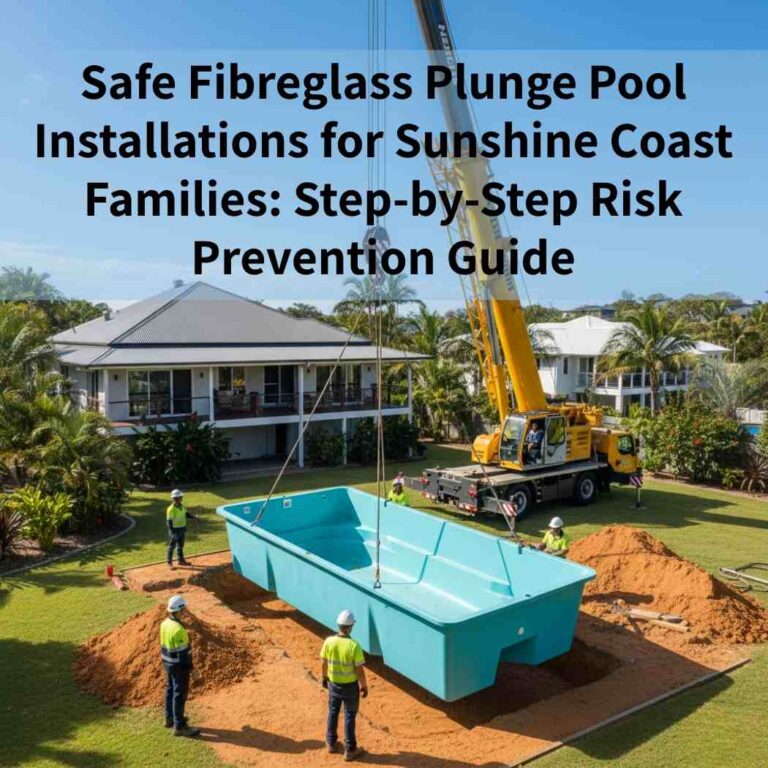At Plunge Pools Sunshine Coast, we build and install stylish fibreglass plunge pools designed for local conditions from the sandy soils of Caloundra to the breezy blocks of Noosa. Our team handles everything from council approvals to pool installation, making sure your new pool is delivered fast and built to last in the coastal climate.
In this guide, you’ll learn what fibreglass plunge pools are, how they’re built, how much they cost, and how to care for them. Whether you’re upgrading your home or building your dream outdoor space, this guide will help you make a confident, stress-free choice.
Table of Contents
ToggleWhat Is a Fibreglass Plunge Pool?
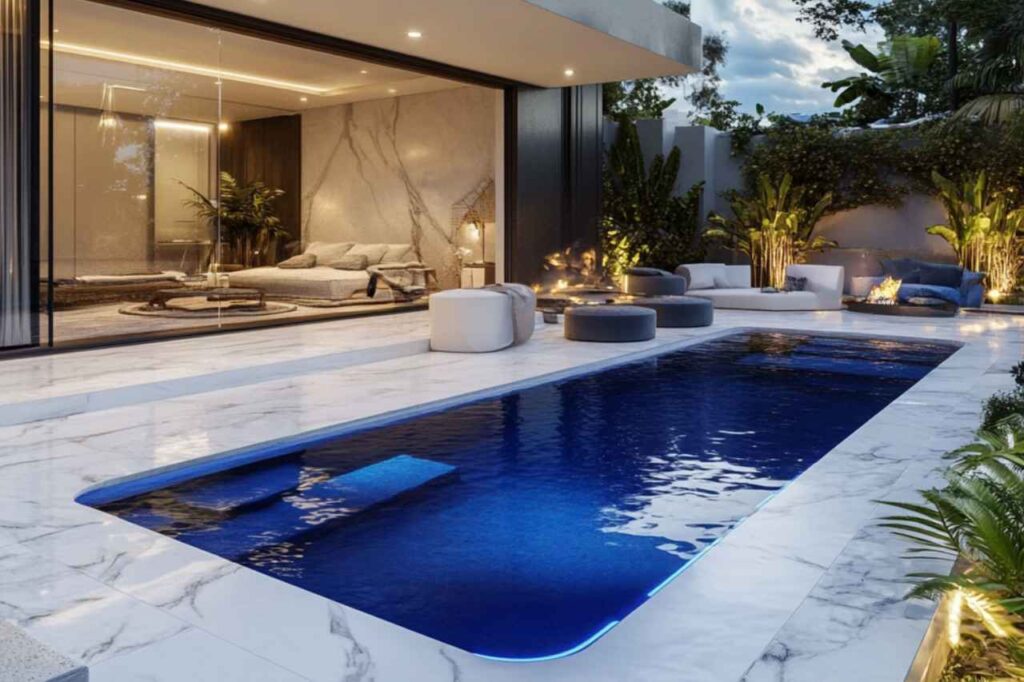
A fibreglass plunge pool is a small, factory-built pool made from a strong fibreglass composite shell. It’s smooth, long-lasting, and ideal for small backyards on the Sunshine Coast. Because it’s pre-moulded, installation takes only a few weeks and maintenance stays simple all year round.
Fibreglass plunge pools are designed for relaxation, cooling off, and hydrotherapy rather than swimming laps. Their compact shape makes them perfect for tight backyard spaces, courtyards, or even sloped blocks. Each shell is moulded in a controlled factory, which ensures a consistent finish and high-quality strength before it’s delivered to your home.
The fibreglass composite material is made of several layers usually gelcoat, vinyl ester resin, and reinforcing fibres that make the pool both durable and flexible. This flexibility is a big advantage for Sunshine Coast homes, where sandy soils and changing temperatures can cause movement over time.
Inside the pool, the smooth, non-porous surface helps prevent algae growth and feels gentle on your skin. You’ll also use fewer pool chemicals and spend less time cleaning, which makes fibreglass one of the most low-maintenance pool types available.
Compared to concrete or vinyl pools, fibreglass plunge pools are faster to install, more affordable, and built to last decades with very little upkeep. For many Sunshine Coast homeowners, it’s the easiest way to enjoy luxury living in a small backyard without the stress or the wait.
Why Choose Fibreglass? Key Benefits Explained
Top Benefits of Fibreglass Plunge Pools:
- Fast installation: Most pools are ready in 4–6 weeks.
- Low maintenance: Smooth surface reduces cleaning time and chemical use.
- Durable: Lasts 20 years or more even in coastal conditions.
- Energy-efficient: Retains warmth, lowering heating costs.
- Eco-friendly: Uses less water and power than concrete pools.
Fibreglass plunge pools are popular across the Sunshine Coast because they offer real value with less work. Unlike concrete pools that can take months to build, a fibreglass pool arrives pre-moulded and ready to install, which cuts down the mess, noise, and time in your backyard. Most homeowners can be swimming within a month.
The smooth, non-porous interior means dirt and algae have nowhere to stick. You’ll spend about $400–$600 a year on upkeep, compared to double that for a concrete pool. Water stays cleaner for longer, and you’ll use fewer chemicals to keep it balanced.
Fibreglass is also known for its strength and flexibility. The composite shell bends slightly under pressure instead of cracking, which is perfect for sandy or reactive soils common from Caloundra to Noosa. Many pools still look new after 20 years with minimal surface repairs.
Another big plus is energy efficiency. The fibreglass shell naturally holds heat, so you can enjoy warm water without running your heater as often. Pair it with solar heating and you’ll enjoy a comfortable dip almost all year while saving on power bills.
Because fibreglass pools use less water and require fewer harsh chemicals, they’re a more eco-friendly choice for coastal living. For Sunshine Coast homeowners who want a stylish, long-lasting pool with low running costs, fibreglass is the smart, sustainable option.
To understand these advantages in more detail, explore our guide on why choosing a fibreglass plunge pool makes sense for Australian backyards.
Also, to make your backyard even greener, check out our guide on sustainable fibreglass plunge pool designs that save both energy and water.
How Fibreglass Technology Has Evolved
Modern fibreglass plunge pools are built using composite layers and gelcoat finishes, a protective coating that stops fading, cracking, and salt damage. These improvements make the pools stronger, smoother, and longer-lasting, ideal for the Sunshine Coast’s coastal climate.
Early fibreglass pools were simple and limited in design. They often came in plain white or light blue with little protection against the sun and salt. Over time, exposure to UV rays could cause fading or dull patches on the surface.
Today’s fibreglass plunge pools are completely different. Manufacturers now use advanced composite materials; layers of vinyl ester resin, reinforced fibreglass matting, and gelcoat that work together for strength and beauty.
The gelcoat layer is the smooth outer surface you see and touch. It’s not just for looks, it’s a protective barrier that prevents UV damage, chemical wear, and saltwater corrosion. This means your pool keeps its shine and colour even after years of exposure to the Sunshine Coast sun.
The middle layers add flexibility and strength, allowing the shell to handle ground movement without cracking. That’s a big plus for coastal and sandy soils, where shifts are more common after heavy rain.
Modern fibreglass technology also brings richer colour options and textured finishes, from deep ocean blues to sleek graphite greys. Some designs even include anti-slip coatings and reflective pigments to keep the surface cooler underfoot.
Thanks to these innovations, today’s fibreglass plunge pools last for decades with very little maintenance, giving homeowners a pool that looks new year after year — no matter how harsh the coastal weather gets.
What Are the Most Popular Shapes and Sizes for Small Backyards?
| Shape | Ideal Space | Common Size |
|---|---|---|
| Rectangular | Courtyards and narrow yards | 4–6 m long |
| Square | Decks, patios, and corner spaces | 3–4 m wide |
| Curved | Garden or landscaped settings | 5–6 m across |
These fibreglass plunge pool shapes make the most of small Sunshine Coast backyards, offering flexibility for tight, sloped, or narrow spaces.
One of the best things about fibreglass plunge pools is how easily they fit into small or unusual backyard shapes. Whether you have a long, narrow courtyard or a compact garden corner, there’s a pool design that works perfectly for your space.
Rectangular plunge pools are the most popular choice because they fit neatly along fences or patios and make great use of tight spaces. Their straight edges also pair well with modern decking or frameless glass fencing, giving your backyard a clean, elegant look.
Square plunge pools work well in corner areas or compact decks. They’re perfect for homeowners who want a stylish pool for cooling off or hydrotherapy without losing valuable garden space.
Curved or round plunge pools create a softer, more natural look that blends nicely with landscaped gardens, palm trees, or tropical plants ideal for achieving that Sunshine Coast resort-style vibe.
Most fibreglass plunge pools measure between 4 to 6 metres in length and 1.2 to 1.5 metres deep, deep enough for a relaxing soak but shallow enough to stay safe for families. Because they come pre-moulded, you can choose the shape and colour that suits your home, and it will arrive ready to install in just a few weeks.
Whether your style is modern and minimal or natural and tropical, there’s a fibreglass plunge pool shape that will make your small Sunshine Coast backyard feel spacious, stylish, and built for relaxation.
How Much Does a Fibreglass Plunge Pool Cost on the Sunshine Coast?
On average, fibreglass plunge pools on the Sunshine Coast cost between $25,000 and $45,000, including installation. Prices change based on pool size, site access, and finishes. In comparison, concrete pools often exceed $70,000, making fibreglass a faster, more affordable option with the same modern look.
Detailed Cost Breakdown:
| Cost Item | Estimated Range (AUD) | Description |
|---|---|---|
| Pool Shell | $12,000 – $20,000 | Factory-made fibreglass shell delivered ready to install |
| Excavation & Site Prep | $4,000 – $8,000 | Digging, soil removal, and ground levelling |
| Plumbing & Filtration | $3,000 – $5,000 | Pumps, pipes, and filtration setup |
| Council Approvals & Certification | $1,000 – $2,000 | Local permits and safety inspections |
| Landscaping & Decking (optional) | $3,000 – $10,000 | Timber decking, paving, or fencing |
| Annual Maintenance | $400 – $600 per year | Water testing, chemicals, and minor servicing |
For most Sunshine Coast homeowners, a fibreglass plunge pool delivers luxury without the high build costs. Because each shell is pre-moulded in a factory, installation takes only a few weeks, saving thousands on labour compared to concrete pools that can take months.
The pool shell makes up nearly half of the total cost, with excavation and plumbing next. Access also affects pricing, tight backyards that need crane delivery may cost more due to equipment hire.
Ongoing costs are low. Expect to spend about $35–$50 a month on chemicals and electricity. The smooth, non-porous surface means you’ll use fewer cleaning products, and less water is wasted through evaporation. Over ten years, fibreglass owners often save $5,000 or more in maintenance compared to concrete pools.
For homeowners in Caloundra, Mooloolaba, or Noosa, where sandy soils and coastal conditions are common, fibreglass pools are also more cost-effective long-term. They require fewer structural repairs and hold up better against salt and heat.
If you’re planning a backyard upgrade, a fibreglass plunge pool offers premium style, lower lifetime costs, and faster installation; all key reasons why it’s the most popular pool choice on the Sunshine Coast.
For homeowners ready to compare real costs and inclusions, our fibreglass plunge pool installation services on the Sunshine Coast provide transparent pricing, licensed builders, and fast turnaround from quote to completion.
What Is the Step-by-Step Installation Process for a Fibreglass Plunge Pool?
Typical Fibreglass Plunge Pool Installation:
- Site Assessment (1 day): Check soil, slope, and backyard access.
- Council Approvals (1–3 weeks): Get fencing, setback, and safety compliance approved.
- Excavation (1–2 days): Dig and level the ground for the pool shell.
- Delivery: A crane lifts and positions the pre-made fibreglass shell.
- Plumbing & Backfill (2–3 days): Connect pumps, filters, and fill soil around the shell.
- Coping & Finishing (3–5 days): Add tiling, decking, and edging.
- Final Check (1 day): Fill the pool, balance the water, and pass safety inspection.
Most homeowners can swim in 4–6 weeks from start to finish, depending on weather and site access.
Installing a fibreglass plunge pool is one of the quickest ways to transform a Sunshine Coast backyard. Because the shell is pre-moulded and delivered ready to install, you skip most of the long construction delays that come with concrete pools. Here’s how the process usually works:
1. Site Assessment – Your installer checks the backyard layout, soil type, and access points for cranes or machinery. This helps plan where the pool will sit and how it will connect with drainage and landscaping.
2. Council Approvals – Every pool on the Sunshine Coast must follow QBCC and council safety rules, including fencing height, boundary setbacks, and electrical clearances. Your installer usually manages this part to make it stress-free.
3. Excavation – Once approvals are done, the ground is marked and dug to match the exact pool dimensions. The base is then compacted and topped with sand or gravel for a smooth, stable foundation.
4. Delivery and Placement – This is the most exciting day for homeowners! The fibreglass shell arrives by truck and is lifted into place with a crane, fitting perfectly into the prepared hole.
5. Plumbing & Backfill – The installer connects all pipes, pumps, and filters, then carefully backfills the area around the shell to keep it level and secure. This stage ensures proper water flow and stability.
6. Coping & Finishing – The pool’s edge is sealed and tiled, then decking, paving, or fencing is added to match your outdoor style. Some homeowners also include LED lighting or spa jets at this stage.
7. Filling & Certification – The pool is filled, water chemistry is balanced, and a final safety inspection is completed. Once approved, it’s ready for your first dip!
In total, the process takes around 4 to 6 weeks, depending on weather conditions, site access, and how quickly council approvals are issued. The result is a beautiful, long-lasting pool that’s installed faster than you might expect.
If you’d like a complete breakdown from site assessment to handover, our guide on installing a fibreglass plunge pool step by step walks through every stage in detail.
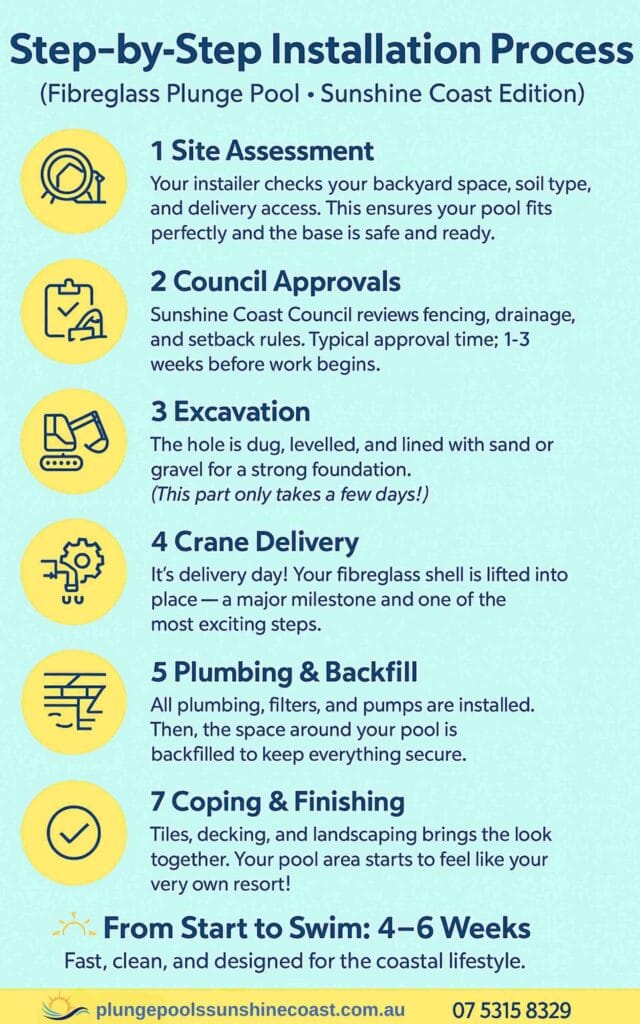
What Are the Common Mistakes to Avoid with Fibreglass Plunge Pools?
Common Mistakes to Avoid with Fibreglass Plunge Pools:
- Poor drainage planning: Sunshine Coast rain and sandy soil can cause the pool to shift if not managed well.
- Weak site preparation: Unlevel ground or soft fill can lead to settling or movement.
- Skipping regular cleaning: Even low-maintenance pools need weekly water checks.
- Using unlicensed installers: Always choose QBCC-licensed builders with SPASA Australia membership.
- Ignoring backfill or plumbing quality: Cheap materials can lead to leaks or pressure issues later.
Even the best fibreglass plunge pools can run into problems if the installation or care isn’t done properly. Avoiding these common mistakes helps your pool last longer and saves you from costly repairs down the line.
1. Poor Drainage Planning
The Sunshine Coast is known for heavy rain and sandy soil. Without proper drainage, water can build up around the pool shell, causing it to shift or float over time. Your installer should include a drainage plan with gravel backfill and stormwater control to keep water flowing away from the pool.
2. Weak Site Preparation
The ground under your pool needs to be compacted and level. Skipping this step can cause uneven settling, which affects the pool’s shape and plumbing connections. Always ensure a solid sand or gravel base before installation.
3. Skipping Regular Cleaning
While fibreglass pools are low maintenance, they still need weekly water testing and occasional brushing. Neglecting simple care can cause algae growth, cloudy water, or filter blockages, all easy to avoid with quick routine checks.
4. Hiring Unlicensed Installers
Not all installers follow proper regulations. To protect your investment, only work with QBCC-licensed professionals who are also members of SPASA Australia. Licensed builders provide warranties and ensure your pool meets Queensland safety standards.
5. Ignoring Plumbing and Backfill Quality
Cheap or rushed plumbing can lead to leaks, pump strain, or poor circulation. Similarly, using the wrong backfill material can create pressure points that stress the pool shell. A reliable installer will use clean, compacted gravel and high-quality fittings to avoid long-term issues.
By avoiding these mistakes, Sunshine Coast homeowners can enjoy a smooth installation, lower maintenance costs, and a fibreglass plunge pool that lasts for decades, no cracks, no leaks, no surprises.
For homeowners who want peace of mind, our guide to safe fibreglass plunge pool installation on the Sunshine Coast explains how to prevent drainage, soil-shift, and compliance risks from the start.
What Customisation Options and Design Features Are Available for Fibreglass Plunge Pools?
Common Fibreglass Pool Features Include:
- Colour finishes like coastal blue, pearl white, or graphite grey
- LED lighting for night swims
- Spa jets or built-in seating for comfort and hydrotherapy
- Tiled edges or feature steps for extra style
One of the best things about fibreglass plunge pools is how easily they can be customised to fit your space, style, and lifestyle. Even though they come pre-moulded, there are plenty of ways to make your pool truly yours.
Lighting & Ambience
Add LED lighting to enjoy warm evening swims or highlight the pool’s shape at night. Many Sunshine Coast homeowners choose multicolour lights that can switch from bright white to soft aqua for a resort feel.
Relaxation Features
Built-in spa jets, benches, or hydrotherapy seats turn a compact pool into a private spa. These features are perfect for cooling off after a hot summer day or relaxing your muscles after exercise.
Tiling & Finishes
Decorative tile bands, mosaic steps, or pebble-look textures give fibreglass pools a premium look without high maintenance. These finishes also add grip to high-traffic areas, keeping the pool safe and stylish.
Colour Choices
Modern fibreglass shells come in a range of coastal colours, from light sky blues that reflect sunlight to deep graphite greys that create a sleek, modern style. The gelcoat layer protects the colour from fading under the Sunshine Coast sun, so your pool stays bright year after year.
Smart Add-ons
You can also include solar heating, automated cleaning systems, or energy-efficient pumps to make your pool easier to maintain and better for the environment.
These design options help transform even the smallest Sunshine Coast backyard into a luxurious outdoor retreat, blending comfort, style, and sustainability in one beautiful package.
Designing Around Your Pool — Landscaping and Decking Ideas
A fibreglass plunge pool becomes the highlight of your backyard when it’s surrounded by the right design. The area around your pool doesn’t just add style but it also improves safety, comfort, and the overall feel of your outdoor space.
Natural Stone and Paving
Many Sunshine Coast homeowners choose travertine or limestone pavers because they stay cool underfoot, even on hot days. These natural stones create a soft, elegant look that fits perfectly with modern homes or beach-inspired designs. For a more budget-friendly option, textured concrete or porcelain tiles can also give a clean and stylish finish.
Timber Decking
Timber decking adds warmth and a natural contrast to the smooth surface of your fibreglass pool. It’s ideal for coastal environments because it blends beautifully with garden plants and outdoor furniture. Choose hardwood or composite decking for better durability against humidity and salt air.
Fencing and Safety
To meet Queensland pool safety standards, every pool needs a compliant fence but that doesn’t mean it has to spoil the view. Many homeowners now use frameless glass fencing to keep the space open and airy while maintaining full safety. Glass panels reflect light and make small backyards feel larger.
Lighting and Ambience
Soft garden lighting, pathway spotlights, or underwater LEDs can completely change how your pool looks at night. Warm white lights create a relaxing atmosphere, while blue or green hues highlight the pool’s shape and waterline.
Plants and Greenery
Add a touch of tropical life with palms, ferns, and coastal grasses that thrive in Sunshine Coast weather. These plants add privacy and movement while helping your pool area stay fresh and vibrant. Low-maintenance greenery like bird of paradise or lomandra works great for that laid-back resort feel.
When combined, these materials and design elements turn a simple fibreglass plunge pool into a coastal-chic retreat. It’s not just about having a pool — it’s about creating an outdoor space that feels calm, stylish, and perfectly in tune with the Sunshine Coast lifestyle..
If you’re short on space or want a modern layered look, explore creative above-ground plunge pool designs that pair perfectly with timber decks and coastal gardens.
Comparing Fibreglass to Other Pool Types
Pool Type Comparison
| Pool Type | Install Time | Lifespan | Maintenance | Cost | Flexibility |
|---|---|---|---|---|---|
| Fibreglass | 4–6 weeks | 20+ years | Low | $$ | Moderate |
| Concrete | 3–6 months | 25+ years | High | $$$$ | High |
| Vinyl | 4–8 weeks | 10–15 years | Moderate | $ | Low |
Fibreglass offers the best balance between cost, speed, and long-term value, making it the top choice for most Sunshine Coast homeowners. Before making your final decision, take a look at our detailed comparison of fibreglass vs concrete plunge pools to understand the trade-offs in cost, maintenance, and longevity.
What’s the Difference Between a Fibreglass Plunge Pool and a Spa?
Snippet-ready answer (featured-snippet format):
| Feature | Fibreglass Plunge Pool | Spa |
|---|---|---|
| Size | Larger and deeper | Smaller and compact |
| Temperature | Can be cool or heated | Hot only |
| Use | Suitable for all seasons | Best for winter or therapy |
| Maintenance | Low and easy | Needs frequent water changes |
| Purpose | Relaxation, cooling off, light exercise | Hydrotherapy and soaking |
Both fibreglass plunge pools and spas are great for relaxing, but they serve slightly different purposes and understanding the difference helps homeowners choose what fits their space and lifestyle best.
A fibreglass plunge pool is usually larger and deeper, giving you more space to stretch, float, or even do light exercises like water walking. You can also install spa jets or heating systems, so it doubles as a warm pool in winter and a cool retreat in summer. This makes it a year-round option for Sunshine Coast homes, where the weather stays warm for most of the year.
A spa, on the other hand, is smaller and hotter. It’s made for hydrotherapy and relaxation, not swimming. Spas heat up quickly and are ideal for cooler evenings, but they can feel limiting during hot months or if you want more space to move around.
Maintenance is another big difference. Spas require frequent water changes and more energy to keep the water hot. Fibreglass plunge pools hold more water, but their smooth, non-porous surface makes cleaning easy and chemical use minimal.
If you want a versatile outdoor feature that looks like a luxury pool but doesn’t take up much space, a fibreglass plunge pool is the smarter choice. You’ll enjoy the flexibility of a cool dip in summer and a heated soak in winter — all in one stylish backyard setup.
How Do You Maintain a Fibreglass Plunge Pool?
To keep your fibreglass plunge pool clean, test the water weekly, brush the walls, and check the filter each month. Annual servicing costs around $400–$600, which is cheaper and easier to maintain than a concrete pool.
Fibreglass plunge pools are known for being low-maintenance, but regular care helps them stay clean, safe, and looking new for years. Because the surface is smooth and non-porous, algae and dirt don’t cling easily, yet a few simple habits will make a big difference.
Weekly Water Testing
Check your pool’s pH and chlorine levels once a week. Balanced water keeps the gelcoat surface bright and prevents corrosion in pumps and fittings. A simple test kit or digital reader can help you do this in minutes.
Light Brushing and Skimming
Even though fibreglass resists algae, brushing the walls gently once a week helps remove fine dust or sunscreen residue. Use a soft nylon brush to avoid scratching the surface. Skim leaves or debris from the surface to keep filters clear.
Filter and Pump Maintenance
Inspect and clean your filter cartridge every month. Fibreglass pools rely on good water circulation, so keeping your pump basket free of debris ensures strong flow and clear water.
Annual Service Checks
Book a professional service once a year to inspect your pool equipment, check seals, and flush the plumbing system. The average cost on the Sunshine Coast is about $400 to $600 per year, depending on pool size and setup, still much cheaper than concrete pools, which often cost double to maintain.
Seasonal Tips
During the warmer months, test your water more often and run your pump longer to manage sunscreen and heavier use. In cooler seasons, reduce pump time but still circulate water daily to avoid stagnation.
With these easy habits, your fibreglass plunge pool will stay clear, smooth, and sparkling all year. Plus, with minimal chemicals and cleaning, you’ll spend more time relaxing and less time maintaining.
How Long Does It Take to Install a Fibreglass Plunge Pool on the Sunshine Coast?
Most Sunshine Coast homeowners can expect the full project from design, approvals, installation, and certification to take around 6 to 8 weeks, though simpler sites may complete in 2–4 weeks and complex sites or slow approvals may stretch beyond.
Installing a fibreglass plunge pool is faster than most people expect, especially compared to concrete pools that can take several months. Because fibreglass shells are pre-moulded in a factory, the whole process from design to your first swim usually takes about 6 to 8 weeks on the Sunshine Coast.
Here’s what the typical timeline looks like:
1. Research & Design (1–2 weeks)
This is where you plan your pool shape, size, and colour, and your installer visits to check soil conditions and site access. They’ll prepare a detailed quote with everything included.
2. Council Approvals (1–3 weeks)
Before construction begins, the Sunshine Coast Council needs to approve fencing, boundaries, and safety compliance. Most installers handle this step for you, but it can take longer depending on local approval times.
3. Excavation & Delivery (1 week)
Once approvals are ready, your backyard is excavated and levelled, and the fibreglass shell is delivered. A crane then lifts it into place one of the most exciting parts of the project.
4. Plumbing, Backfill & Finishing (2–3 weeks)
Next comes the technical stage: connecting pumps, pipes, and filtration systems, then carefully backfilling around the shell. After that, your tiling, decking, paving, or landscaping are completed to finish the area.
5. Filling & Certification (1 week)
Finally, your pool is filled with water, the chemistry is balanced, and a final safety inspection is done for certification. Once approved, it’s ready for your first swim.
Most installations are done within 6 to 8 weeks, though simpler sites with quick approvals can finish in as little as 2 to 4 weeks, while more complex or weather-affected projects may take slightly longer. Either way, it’s a fast and efficient process that delivers a luxury plunge pool in time for the next Sunshine Coast summer.
How Do You Choose the Right Pool Installer on the Sunshine Coast?
To choose the right pool installer on the Sunshine Coast, look for QBCC-licensed builders who are members of SPASA Australia, have proven local experience, and provide clear quotes with full inclusions. The best installers handle council approvals, drainage, and aftercare ensuring a smooth, worry-free build from start to finish.
Picking the right installer is the most important part of building a fibreglass plunge pool. A good builder doesn’t just install the shell, they make sure your pool is safe, durable, and perfectly suited to your property.
Check for Licences and Memberships
Always choose a QBCC-licensed pool builder. This licence proves the company meets Queensland’s construction and safety standards. Membership in SPASA Australia (Swimming Pool & Spa Association) is another strong sign of professionalism and reliability. It also means your pool will be covered by recognised warranty protections.
Look for Local Experience
A local installer understands Sunshine Coast conditions from sandy soils and heavy rain to council setback rules. Builders with experience in suburbs like Caloundra, Maroochydore, and Noosa know how to manage site access and drainage better than out-of-town companies.
Ask for Transparent Quotes
Reliable installers provide detailed written quotes that list every cost, from excavation to plumbing. Avoid vague estimates or verbal agreements. A clear quote helps you compare prices and avoid surprise fees later.
Review Previous Projects
Check reviews, visit display pools, or ask to see photos of previous installations. Seeing their work helps you understand their finish quality and attention to detail.
Communication and Support
A professional pool builder will guide you through every step from design and council approvals to aftercare and maintenance tips. Look for someone who communicates clearly and responds quickly to questions.
For a durable, low-maintenance option that’s built to last, our licensed team specialises in fibreglass plunge pool installation across the Sunshine Coast.
Before signing a contract, it’s smart to review our checklist on what to look for before buying a fibreglass plunge pool from shell warranties to installation standards.
Does a Fibreglass Plunge Pool Add Value to Your Home?
Yes. A well-installed fibreglass plunge pool can add up to 7% to your property value in the right market conditions, especially in coastal areas like the Sunshine Coast where pools are highly desired. Beyond property value, it also offers daily relaxation, stronger buyer appeal, and a better outdoor lifestyle.
Adding a fibreglass plunge pool is one of the smartest upgrades you can make for your home. It doesn’t just look great but also brings long-term financial and lifestyle benefits that pay off over time.
Boosting Property Value
Real estate experts, including HouseLogic (via realestate.com.au), report that a pool can raise a home’s value by up to 7% when well-maintained and suited to the local climate. On the Sunshine Coast, where outdoor living is part of everyday life, a modern plunge pool is seen as a desirable feature that helps homes stand out in the market.
Lifestyle ROI
The real value goes beyond money. A plunge pool gives you a private place to relax, cool off, or enjoy family time without leaving home. It turns your backyard into a mini resort, a feature many Sunshine Coast homeowners say improves their quality of life and helps them spend more time outdoors.
Low Long-Term Costs
Compared with concrete pools, fibreglass plunge pools are cheaper to maintain and use less water and energy. The smooth surface cuts down on chemicals, and the durable shell lasts for decades with little repair work. This makes the long-term return even better, as running costs stay low year after year.
Buyer Appeal and Resale Advantage
When it’s time to sell, a well-kept fibreglass plunge pool can make your home more attractive to buyers looking for a balance between luxury and low maintenance. Compact designs fit smaller blocks perfectly, a major plus for today’s Sunshine Coast buyers who want comfort without the extra upkeep.
In short, a fibreglass plunge pool offers the best of both worlds, a strong lifestyle return and a potential value boost of up to 7% when installed and maintained properly. It’s a lasting investment that adds joy, beauty, and appeal to your home every single summer.
Conclusion
A fibreglass plunge pool proves that you don’t need a huge yard to enjoy a stunning outdoor oasis. With smart design, modern materials, and the right installer, you can bring resort-style living right to your home.
Whether you’re in Caloundra or Noosa, our team specialises in designing and installing fibreglass plunge pools built for Sunshine Coast homes, combining durability, speed, and local expertise for a flawless finish.
Ready to start your own backyard transformation?
Reach out to Plunge Pools Sunshine Coast — your local fibreglass pool experts — and let’s bring your compact luxury pool to life.
FAQs
Can fibreglass plunge pools be installed on small or sloped backyards?
Yes. Fibreglass plunge pools are perfect for small or sloped spaces. Their compact, pre-moulded shells fit tight yards easily, and with proper engineering, builders can use retaining walls or partial above-ground setups for a safe, seamless installation across the Sunshine Coast.
What design and customisation options are available for fibreglass plunge pools?
Modern fibreglass plunge pools can be customised with LED lighting, spa jets, built-in seating, and decorative tiles. Sunshine Coast homeowners often add timber decking, tropical gardens, or stone surrounds to create a private retreat that suits their backyard style.
Are fibreglass plunge pools energy-efficient and eco-friendly?
Yes. Fibreglass plunge pools are energy-efficient and sustainable. Their insulated, non-porous surface retains warmth longer, reducing heating costs. They also use less water and fewer chemicals, making them an eco-friendly option for coastal homes.
How has fibreglass pool technology improved in recent years?
Modern fibreglass pools use stronger composite layers, UV-resistant coatings, and gelcoat finishes that stop fading and cracking. These upgrades make today’s pools longer-lasting, safer, and easier to maintain, with built-in seating and smarter filtration systems.
What future trends are shaping plunge pool design and outdoor living in coastal Queensland?
Popular plunge pool trends include automated cleaning, solar heating, frameless glass fencing, and minimalist landscaping. Sunshine Coast homeowners love clean, open designs that blend the pool with the garden, creating stylish spaces that stay low-maintenance and timeless.

